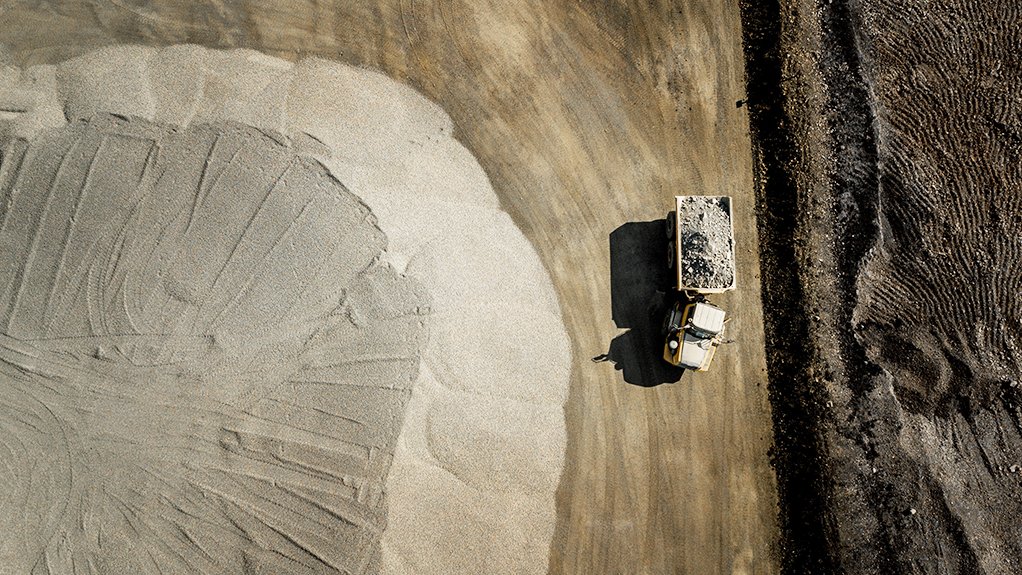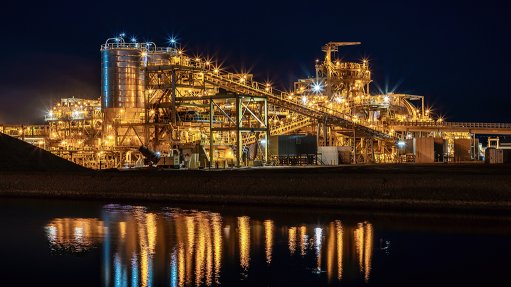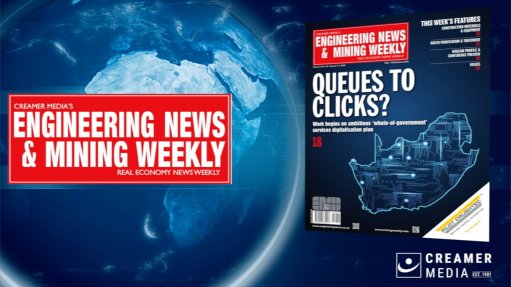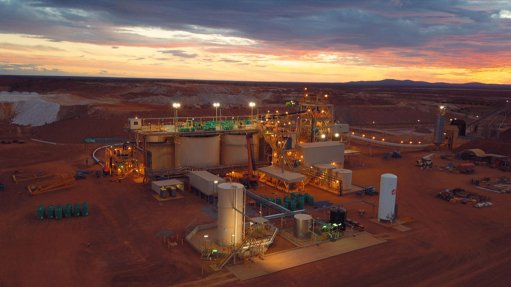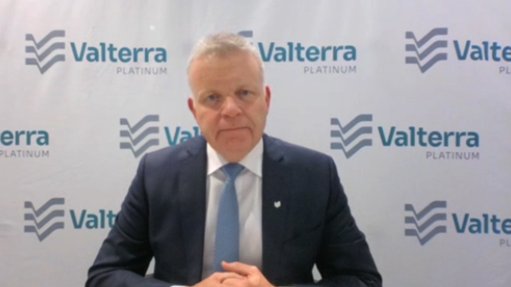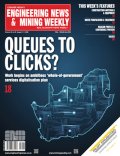Afrimat attributes higher revenue to diversification strategy
Midtier openpit mining company Afrimat has reported a 4.9% year-on-year increase in revenue from R4.7-billion to R4.9-billion for the financial year ended February 28.
Speaking at the company’s year-end results presentation on May 18, in Johannesburg, Afrimat CEO Andries van Heerden said the company’s results were supported by its diversification strategy.
“Diversification, increased volumes from the mines coming online, and efficiency improvement initiatives remain the cornerstone of our strategy and are used to counter macroeconomic impacts beyond management’s control,” he said.
Afrimat’s diversification strategy has seen the company invest in industrial minerals, bulk commodities, construction materials, as well as future materials and metals – such as phosphate, vermiculite and rare earth minerals.
Van Heerden explained that the rationale for its strategic diversification structure included benefitting from a good blend of locally and internationally priced commodities, as well as more exposure to different currencies and different economic cycles.
The company also benefitted owing to its ability to transfer skills across different business commodities owing to similar operational skills required in each.
This had enabled a smooth growth trajectory for more than a decade, Van Heerden explained, which allowed for a longer life-of-mine across the company’s projects. Moreover, a diversification mindset created many opportunities, he added.
“However, the structural decline in the public sector’s contribution to fixed investment and infrastructure remains a concern,” Van Heerden said.
He noted several strategic initiatives which contributed positively to the company’s performance. These included the successful commissioning of the Jenkins iron-ore mine, in the Northern Cape; the turnaround of the Nkomati anthracite mine, in Mpumalanga; and ongoing continuous improvement initiatives at other ongoing operations.
Detractors from the financial performance were the decrease in iron-ore prices and the economic slowdown, which impacted on Afrimat’s construction materials and industrial minerals businesses, exacerbated by a rise in input costs such as diesel, explosives and electricity.
Afrimat’s operating profit decreased by 13.3% from R1.1-billion to R1-billion, resulting in the operating profit margin declining from 23.7% to 19.6%.
A rise in future volumes, as these mines reach a steady state, was expected in the coming year, Van Heerden said.
Headline earnings per share (HEPS) declined by 15.7% from R5.43 to R4.58.
Net cash from operating activities of R1-billion was generated, as well as R680-million from a successful equity raise during the year, resulting in the net debt-to-equity ratio decreasing from 12.1% to 4.4%.
In addition to this, R963-million was advanced into various capital investments during the year. Van Heerden said this strong cash generation would enable Afrimat to execute its growth strategy.
As a result of the company’s performance, Afrimat declared a final dividend of R1.10 a share.
Van Heerden believed that Afrimat’s diversified operating units were strategically positioned to deliver customer service while ensuring protection against volatile local business conditions.
“Our product range is wide, diversified and, importantly, growing,” he said.
The bulk commodities segment, consisting of the Demaneng and Jenkins iron-ore mines, and the Nkomati anthracite mine, contributed 81.9% to the company’s operating profit. This performance was largely owing to increased volumes from Jenkins coming into production, and the successful turnaround of Nkomati, in addition to cost-saving initiatives.
Jenkins is fully operational and, together with Demaneng, sold more than 1.28-million tonnes for the year, up from about 1.19-million tonnes in the previous year.
Although the operating profit decreased by 15.6% because of the decline in the iron-ore price and a rise in input costs, an operating profit margin of 40.3% was generated from the iron-ore mines.
“This segment is well-positioned to weather the volatility of the iron-ore price because it is a low-cost producer and has fixed pricing agreements for its inland iron-ore and anthracite revenue,” Van Heerden explained.
He added that the allocation of trains from State-owned Transnet had also become more consistent.
“Innovative technology solutions, which optimise mine fleet efficiency were rolled out at Jenkins and Demaneng, resulting in cost savings which countered, to an extent, the rise in the diesel price and the fall in the iron-ore price,” Van Heerden said.
Notably among Afrimat’s operations, Nkomati turned from initial start-up losses to being profitable and contributed 23.1% to the segment’s revenue for the year. It produces a high-quality product sold into the local market, serving as an alternative to imported anthracite.
During the 2023 financial year, volumes at Nkomati amounted to 317 943 t, which was up from the previous year’s 219 845 t. Moreover, Van Heerden said that a new operational strategy was being implemented by the mine, which he expected would improve performance significantly in the near future.
Van Heerden explained that the life-of-mine plan, designed to sustain the project long-term, was being enhanced through the opening of two opencast pits and the continued development of the underground operations.
“The first anthracite from these developments was extracted early in the new financial year. These planned new sources will enhance the mine’s production capacity significantly,” he said.
Van Heerden added that the industrial minerals businesses across all regions had delivered satisfactory results, given the current economic operating conditions.
“However, the impact of the economic slowdown was exacerbated by electricity supply interruptions, resulting in a decrease in operating profit of 41.9% from R84.9-million to R49.4-million,” he explained.
Afrimat’s construction materials segment also felt the impact of the slowdown in economic activity. The overall reduction in construction activity and electricity supply interruptions caused operating profit to decrease by 17.7% from R157.5-million to R129.6-million.
The future materials and metals business unit is the most recent segment to be added to Afrimat in support of its diversification strategy, with the Glenover phosphate mine, in Limpopo, being the segment’s first project.
This mine serves to diversify Afrimat’s exposure beyond ferrous metals. Van Heerden said the project better aligned the company with global trends such as the advancement of technology for decarbonisation through rare earth minerals, as well as food security through fertiliser products.
“Glenover is a greenfield project that started its first production during the year and is currently in ramp-up phase. The project contains three essential businesses – fertiliser for agricultural applications; vermiculite for various applications from industrial to horticulture; and rare earth elements, supporting technological advancements such as high-strength permanent magnets and battery technology,” Van Heerden explained.
He revealed that revenue of R25.2-million was generated by the future materials and metals segment, with start-up losses of R11.4-million.
“Looking ahead, careful project implementation and the rollout of a well-thought-through strategy for Glenover will be a top priority. This is expected to include vermiculite processing, optimisation of the high-grade phosphate project, and the implementation of the super single phosphate project. These product lines will add additional volumes in future,” Van Heerden stated.
In terms of sustainability, he believes various non-financial aspects also contributed significantly to Afrimat's resilience over the period.
“During the year, we maintained good labour relations, and pleasingly no labour action or significant community actions occurred. Employee development, training and education remain priorities,” Van Heerden said.
Afrimat has a total employee count of 2 668. A total of 11 836 training days for employees were undertaken during the financial year, supplemented by the issuance of 66 staff bursaries.
Meanwhile, Van Heerden said work on Afrimat’s carbon neutrality strategy continued.
“An initial renewable energy project to reduce carbon emissions is under way at Glen Douglas Dolomite [in Gauteng]. A target is set to decrease carbon emissions by 32% by 2030,” he said.
Overall, Van Heerden believes the company is positioned to capitalise on strategic initiatives and future opportunities, adding that future growth will be driven by the successful execution of Afrimat’s diversification strategy, recent acquisitions, and a wider product offering to the market, with several additional potential opportunities being investigated.
“We continue to focus on sustainable diversification in all five segments. In the new future materials and metals segment, the priority is to ramp up the production of high-grade phosphate and to execute the next stages of the project as seamlessly as possible, while the bulk commodities segment has implemented an internal efficiency drive with new technology, which has proven to be highly successful.
“These solutions will now be implemented throughout the group to improve efficiencies and margins further,” he said.
He added that these efficiency initiatives were aimed at countering inflationary mining cost increases.
Van Heerden further said the Driehoekspan and Doornpan iron-ore assets in the Northern Cape still needed to be brought online once Demaneng volumes began to decline.
“This should be within the next three years. To optimise production, Nkomati is in the process of opening up two opencast mine areas as well as an underground access point. Volumes are expected to ramp up and the processing plant can take on additional production. Increased volumes from Nkomati and Jenkins, which are not exposed to international iron-ore price volatility, effectively buffer us against potential downturns in export iron-ore prices,” Van Heerden said.
In Afrimat’s industrial minerals and construction materials business segments, market and product development were ongoing. Operational efficiency initiatives aimed at expanding volumes, reducing costs, and developing the required skill levels across all employee categories remained key focus areas for the company, he noted.
Comments
Press Office
Announcements
What's On
Subscribe to improve your user experience...
Option 1 (equivalent of R125 a month):
Receive a weekly copy of Creamer Media's Engineering News & Mining Weekly magazine
(print copy for those in South Africa and e-magazine for those outside of South Africa)
Receive daily email newsletters
Access to full search results
Access archive of magazine back copies
Access to Projects in Progress
Access to ONE Research Report of your choice in PDF format
Option 2 (equivalent of R375 a month):
All benefits from Option 1
PLUS
Access to Creamer Media's Research Channel Africa for ALL Research Reports, in PDF format, on various industrial and mining sectors
including Electricity; Water; Energy Transition; Hydrogen; Roads, Rail and Ports; Coal; Gold; Platinum; Battery Metals; etc.
Already a subscriber?
Forgotten your password?
Receive weekly copy of Creamer Media's Engineering News & Mining Weekly magazine (print copy for those in South Africa and e-magazine for those outside of South Africa)
➕
Recieve daily email newsletters
➕
Access to full search results
➕
Access archive of magazine back copies
➕
Access to Projects in Progress
➕
Access to ONE Research Report of your choice in PDF format
RESEARCH CHANNEL AFRICA
R4500 (equivalent of R375 a month)
SUBSCRIBEAll benefits from Option 1
➕
Access to Creamer Media's Research Channel Africa for ALL Research Reports on various industrial and mining sectors, in PDF format, including on:
Electricity
➕
Water
➕
Energy Transition
➕
Hydrogen
➕
Roads, Rail and Ports
➕
Coal
➕
Gold
➕
Platinum
➕
Battery Metals
➕
etc.
Receive all benefits from Option 1 or Option 2 delivered to numerous people at your company
➕
Multiple User names and Passwords for simultaneous log-ins
➕
Intranet integration access to all in your organisation



